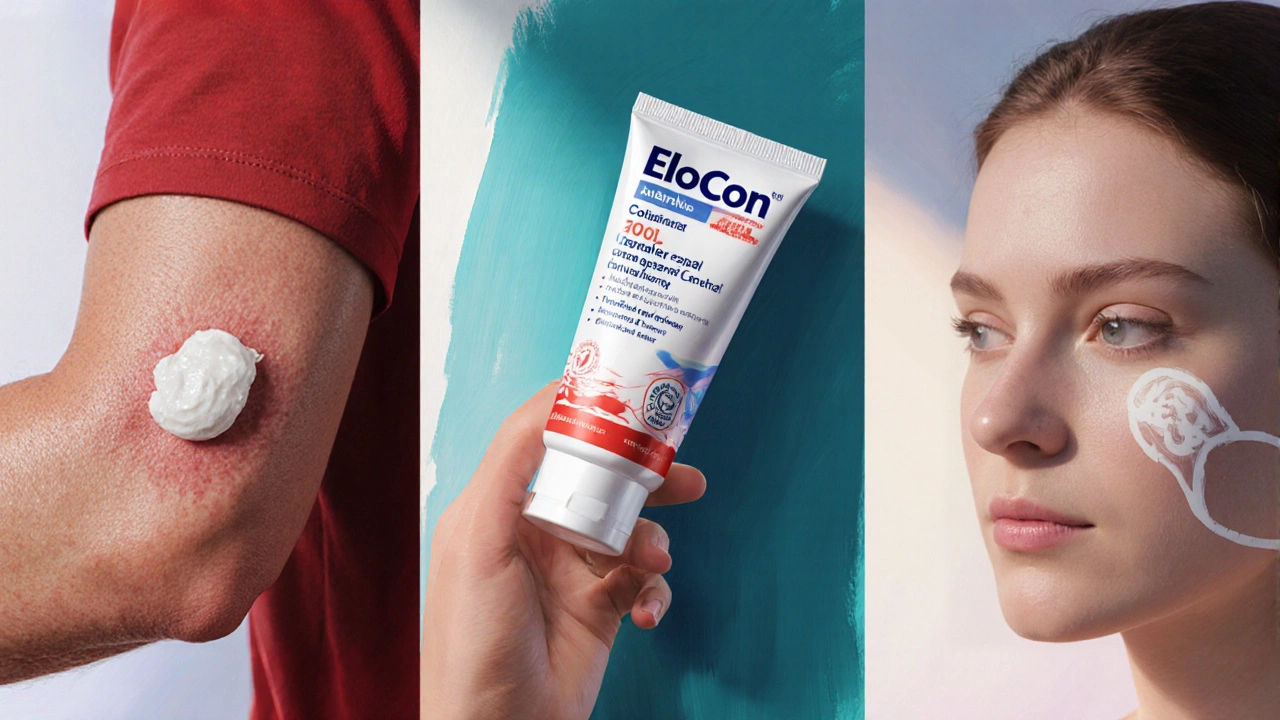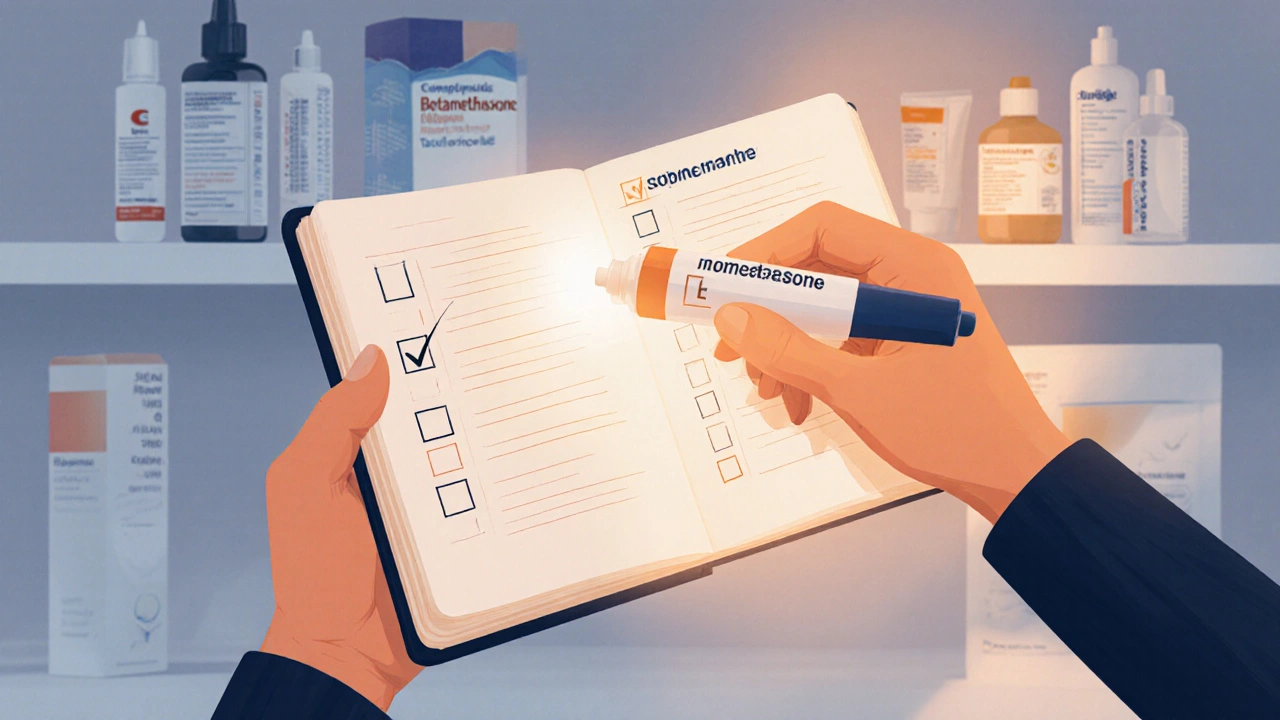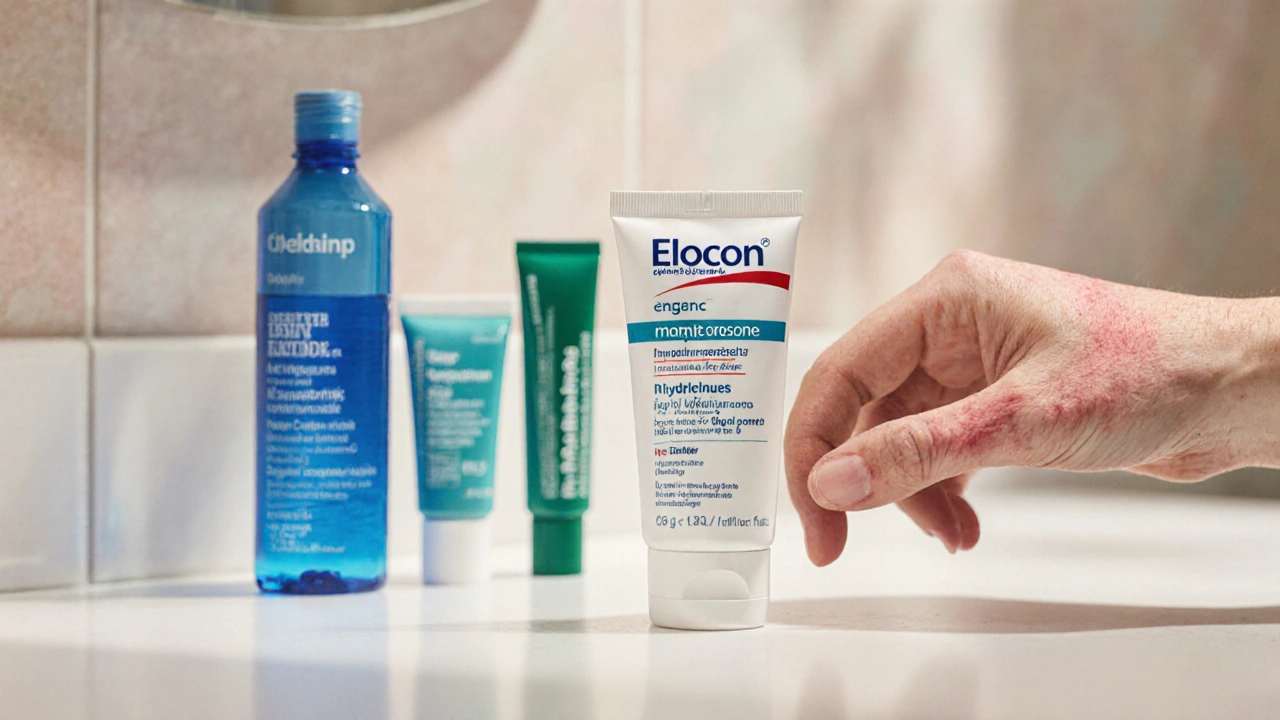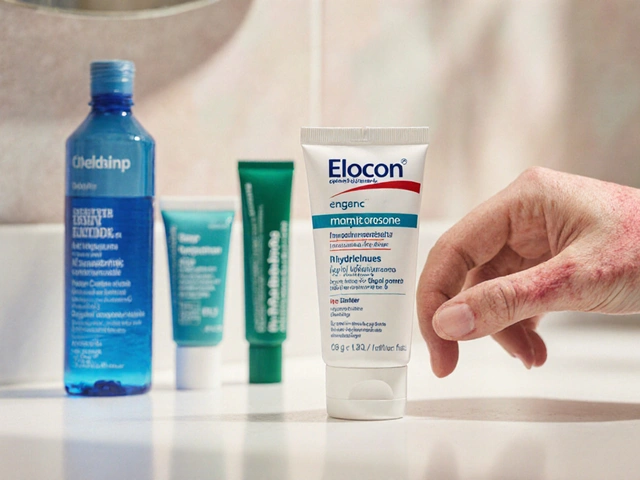Topical Steroid Decision Tool
Find Your Best Topical Steroid
This tool helps match your skin condition to the most appropriate topical treatment based on severity, body area, and other factors.
When you’re battling eczema, psoriasis, or stubborn dermatitis, the first question is usually: Elocon or something else? The market is crowded with creams, ointments, and gels that promise relief, but they differ in strength, side‑effects, and cost. This guide breaks down Elocon (mometasone) side by side with the most common alternatives, so you can pick the product that matches your skin’s needs and your doctor’s prescription.
Key Takeaways
- Elocon is a mid‑strength corticosteroid (class III) ideal for moderate eczema and psoriasis.
- Stronger steroids like clobetasol work faster but raise the risk of skin thinning.
- Non‑steroid options such as tacrolimus and crisaborole are useful for sensitive areas or long‑term maintenance.
- Cost varies widely: generic mometasone is cheap, brand‑only drugs can be two‑to‑three times more.
- Choosing the right product depends on potency, treatment duration, body area, and insurance coverage.
How Elocon (Mometasone) Works
Elocon is a prescription‑only, medium‑potency topical corticosteroid (mometasone furoate) that reduces inflammation, itching, and redness by suppressing the immune response in the skin. It is typically prescribed as a 0.1% cream, ointment, or lotion and is safe for use on the body, scalp, and limbs for up to two weeks per course.
Comparison Criteria
To make an apples‑to‑apples comparison, we look at five core attributes:
- Potency class - how strong the steroid’s anti‑inflammatory action is.
- Prescription status - over‑the‑counter (OTC) vs prescription only.
- Typical use cases - eczema, psoriasis, contact dermatitis, facial skin, etc.
- Side‑effect profile - risk of skin thinning, HPA‑axis suppression, burning, etc.
- Cost & insurance - average retail price for a 30‑gram tube and likelihood of coverage.

Side‑by‑Side Comparison Table
| Product | Potency (FDA class) | Prescription? | Common Indications | Key Side Effects | Average Cost (USD) |
|---|---|---|---|---|---|
| Elocon (Mometasone) | III (mid‑strength) | Prescription | Eczema, psoriasis, dermatitis | Skin thinning (rare), burning | $12‑$18 (generic) |
| Hydrocortisone | I‑II (low) | OTC (1%) / Prescription (2‑2.5%) | Mild eczema, insect bites | Minimal, occasional irritation | $5‑$8 |
| Triamcinolone | III (mid‑strength) | Prescription | Moderate eczema, psoriasis | Skin atrophy, telangiectasia | $10‑$15 |
| Betamethasone | IV (high) | Prescription | Severe psoriasis, lichen planus | Higher risk of thinning, systemic absorption | $15‑$25 |
| Clobetasol | VII (very high) | Prescription | Severe plaque psoriasis, resistant dermatitis | Significant thinning, striae, HPA suppression | $20‑$30 |
| Tacrolimus (Protopic) | Non‑steroid | Prescription | Atopic dermatitis on face/neck | Burning, itching (usually mild) | $70‑$120 |
| Pimecrolimus (Elidel) | Non‑steroid | Prescription | Mild‑to‑moderate eczema, especially in children | Mild irritation, rare infection risk | $55‑$90 |
| Crisaborole (Eucrisa) | Non‑steroid | Prescription (often covered by insurance) | Minor to moderate eczema | Transient burning, minimal systemic risk | $70‑$110 |
Deep Dive into Each Alternative
Hydrocortisone
Hydrocortisone is the classic low‑potency steroid you can find on a pharmacy shelf. It’s gentle enough for use on the face and intertriginous areas, but its anti‑inflammatory punch is modest. If you have mild eczema or a short flare‑up, a 1% OTC cream can be enough. For thicker lesions, doctors may step up to a 2.5% prescription version, which still stays in the low‑potency bracket.
Triamcinolone
Triamcinolone hits the same potency class as Elocon (classIII), but it’s available in a variety of bases - cream, ointment, or lotion. The ointment version can feel greasier, yet it penetrates better into thick plaques. Some clinicians prefer it for scalp psoriasis because the oily base clings to hair.
Betamethasone
A step up in strength, betamethasone falls into classIV. It’s often chosen when mometasone isn’t providing quick enough relief. However, the higher potency brings a higher chance of skin atrophy if used for more than two weeks continuously. It’s best saved for stubborn plaques or short‑term “burst” therapy.
Clobetasol
Clobetasol is the heavyweight champion of topical steroids (classVII). Doctors typically reserve it for severe plaque psoriasis, thick nummular eczema, or for short “bridge” periods while switching to a milder maintenance regimen. Because it can suppress the hypothalamic‑pituitary‑adrenal (HPA) axis, patients must avoid large surface‑area applications and prolonged use.
Tacrolimus (Protopic)
Unlike steroids, tacrolimus is a calcineurin inhibitor. It modulates the immune system without causing skin thinning, making it a favorite for delicate zones like the face, eyelids, and groin. The downside is cost - often three‑times higher than generic steroids - and a characteristic burning sensation that usually fades after a few weeks.
Pimecrolimus (Elidel)
Pimecrolimus shares the same mechanism as tacrolimus but comes in a lighter cream. It’s approved for children six months and older, so many pediatric dermatologists prescribe it for facial eczema where steroids might be too risky.
Crisaborole (Eucrisa)
Crisaborole is a phosphodiesterase‑4 (PDE‑4) inhibitor. It works by reducing inflammatory cytokines directly in the skin. Because it’s non‑steroidal, long‑term use doesn’t lead to thinning, but its efficacy is generally modest - best for mild‑to‑moderate flare‑ups.
When to Choose Elocon Over Alternatives
Elocon shines in these scenarios:
- Moderate eczema or psoriasis that hasn’t responded to low‑potency steroids.
- Body areas with thicker skin - elbows, knees, hands - where you need a stronger anti‑inflammatory effect without jumping to classIV‑VII.
- Patients who prefer a short‑term prescription - the typical 2‑week course balances effectiveness and safety.
- Insurance‑friendly options - generic mometasone is widely covered, keeping out‑of‑pocket costs low.

Decision Guide: Picking the Right Product
- Identify the severity of your skin condition (mild, moderate, severe).
- Locate the body area involved (face, scalp, limbs, large surface).
- Check your tolerance for potential side effects (skin thinning vs burning).
- Review your insurance coverage and budget.
- Match the above factors to the table - start with the lowest potency that’s likely to work, then step up if needed.
For example, a patient with mild facial eczema would start with a low‑potency hydrocortisone or a non‑steroid like tacrolimus. If the rash spreads to the forearms and becomes more inflamed, moving to Elocon provides a stronger hit without the high‑risk profile of clobetasol.
Potential Pitfalls & How to Avoid Them
- Over‑use of high‑potency steroids - limit clobetasol or betamethasone to less than 2weeks on any single area.
- Ignoring the vehicle - ointments deliver more drug to thick plaques; creams are better for moist areas.
- Skipping a taper - abruptly stopping a medium‑potency steroid can cause rebound flares; a short taper week can smooth the transition.
- Cost surprise - ask your pharmacist about generic equivalents before paying full price for brand‑only options.
Frequently Asked Questions
Can I use Elocon on my face?
Yes, but only for short courses (up to 2weeks) and under a doctor’s guidance. For chronic facial eczema, non‑steroid options like tacrolimus are usually safer.
How does the cost of generic mometasone compare to brand‑only alternatives?
A 30‑gram tube of generic mometasone typically costs $12‑$18, whereas brand‑only non‑steroidal creams like tacrolimus or crisaborole can run $70‑$120. Insurance often covers the generic steroid, making it the most budget‑friendly choice.
Is it safe to alternate between Elocon and a non‑steroid like crisaborole?
Alternating can be effective: use Elocon for rapid flare control, then switch to crisaborole for maintenance to avoid long‑term steroid exposure. Always follow the timing and taper recommendations from your dermatologist.
What are the signs of steroid overuse I should watch for?
Look for thinning skin, easy bruising, stretch marks (striae), or a persistent burning sensation. If any appear, stop the product and consult your doctor for a gentler alternative.
Can I buy Elocon without a prescription online?
No. In the U.S., mometasone furoate is a prescription‑only medication. Any online source offering it without a prescription is likely operating illegally or selling counterfeit products.
Next Steps
1. Schedule a brief appointment with your dermatologist to discuss the severity and location of your rash.
2. Ask specifically whether a mid‑potency steroid like Elocon fits your case or if a gentler option is recommended.
3. Check your insurance portal for coverage on generic mometasone versus brand‑only alternatives.
4. If you’re prescribed Elocon, follow the two‑week course, then switch to a maintenance cream (either a low‑potency steroid or a non‑steroid) to keep flare‑ups at bay.
By matching potency, side‑effect risk, and cost to your personal situation, you can get relief without compromising skin health. Whether you stay with Elocon or move to a different class, the key is a clear plan and regular follow‑up.



Sophie Rabey
October 12 2025Wow, because everyone knows the biggest breakthrough in dermatology is just picking between a class‑III steroid and a fancy‑priced PDE‑4 inhibitor.
Bruce Heintz
October 12 2025Great looking at how the potency class lines up-mid‑strength mometasone can tame moderate eczema without the drama of a super‑potent steroid 😊. Stick to a short two‑week course and then transition to a low‑potency maintenance cream.
richard king
October 13 2025In the grand theater of skin, the actor called Elocon plays the role of the pragmatic hero, daring enough to quell inflammation yet humble enough to avoid the tragic side‑effects that haunt the egos of high‑potency rivals.
Dalton Hackett
October 14 2025When you weigh the therapeutic landscape of topical corticosteroids, the first axis of comparison is the FDA potency class, which dictates how aggressively the molecule will suppress the cutaneous immune cascade.
Mometasone furoate, marketed as Elocon, occupies class III, positioning it squarely between gentle hydrocortisone and the heavyweight champions betamethasone and clobetasol.
Because of its intermediate strength, it delivers noticeable itch relief within a few days, often obviating the need for a rapid escalation to class IV or VII agents.
The pharmacokinetic profile of mometasone favors a low systemic absorption rate, a feature that becomes particularly valuable when treating larger body surface areas.
However, the vehicle matters; the cream formulation penetrates oily plaques better than the lotion, while the ointment sticks to dry, scaly regions with superior occlusion.
Patients with facial or intertriginous involvement should usually start with non‑steroid calcineurin inhibitors, as the skin in those zones is thin and more prone to atrophy.
If a clinician elects to use Elocon on the face, the recommendation is a maximum of two weeks, followed by a taper or a switch to a low‑potency steroid like hydrocortisone.
Cost considerations also tilt the balance; generic mometasone can be purchased for under $15 for a 30‑gram tube, whereas brand‑only tacrolimus may exceed $100.
Insurance formularies often place mometasone on a preferred tier, making it a budget‑friendly option for many patients.
From a safety standpoint, the most common adverse event is a mild burning sensation that typically resolves as the skin adapts.
Rarely, prolonged use beyond the recommended duration can lead to subtle epidermal thinning, which is why clinicians advise a drug holiday after a few cycles.
In contrast, high‑potency steroids like clobetasol can produce dramatic improvement in a week but carry a far higher risk of striae, telangiectasia, and even hypothalamic‑pituitary‑adrenal axis suppression.
Therefore, the decision algorithm presented in the post wisely suggests escalating potency only after a trial of mid‑strength agents fails.
For patients without insurance coverage, a switch from a brand‑only non‑steroid to a generic mometasone often resolves the affordability barrier without sacrificing efficacy.
In summary, Elocon serves as the versatile workhorse of the topical armamentarium, offering a balance of potency, safety, and cost that fits the majority of moderate eczema and psoriasis cases.
William Lawrence
October 14 2025Sure, because pouring on the strongest steroid is always the answer.
Grace Shaw
October 15 2025While evaluating topical options, one must consider both pharmacologic potency and anatomic suitability. Elocon, as a class III corticosteroid, delivers sufficient anti‑inflammatory action for moderate dermatoses without the heightened risk profile of class IV‑VII agents. Nevertheless, its use on delicate areas such as the face or intertriginous zones should be limited to brief courses, typically not exceeding fourteen days. Physicians should advise a tapering regimen or a transition to a low‑potency steroid to mitigate rebound phenomena. Moreover, insurance coverage frequently favors generic mometasone, rendering it a cost‑effective choice for many patients. In practice, the clinician’s judgment remains paramount when balancing efficacy against potential adverse effects.
Sean Powell
October 16 2025Elocon is a sweet spot mediatium steroid it works good on elbows knees and arms but dont throw it on your smiley face or under the boobs where skin is thin you want something like tacrolimus or a low strength hydrocortisone for those spots keep it simple
Emily Collier
October 16 2025For anyone navigating the Elocon versus alternatives maze, start by categorizing the severity of your flare and the body region involved. If your eczema is moderate and located on sturdy skin such as the limbs or trunk, Elocon often provides rapid relief with a manageable side‑effect profile. When the rash appears on the face, eyes, or groin, consider non‑steroidal options like tacrolimus to avoid thinning. Always check your pharmacy’s generic pricing; mometasone is usually the most wallet‑friendly prescription. Follow the dermatologist’s two‑week limit and then shift to a maintenance regimen to keep the skin barrier intact.
Brian Mavigliano
October 17 2025One could argue that the appeal of non‑steroid agents lies more in marketing hype than in clinical superiority for moderate disease, yet the avoidance of steroid‑induced atrophy remains a compelling rationale.
Emily Torbert
October 18 2025Agreed, the key is to balance effectiveness with safety; switching after a short Elocon course keeps the skin happy.
Rashi Shetty
October 18 2025From a doctrinal standpoint, the hierarchy of topical potency must be respected; misuse of class VII agents on mild lesions is a transgression that compromises epidermal integrity. 💡 Moreover, the economic dimension cannot be ignored-generic mometasone delivers comparable outcomes to many brand‑name alternatives at a fraction of the cost. 📊 Patients should thus prioritize evidence‑based selection over brand allure. 🧴 Finally, adherence to the prescribed duration prevents iatrogenic complications and preserves therapeutic gain. 🌟
Queen Flipcharts
October 19 2025Patriotically speaking, embracing domestically produced generics fortifies our healthcare sovereignty while shielding citizens from predatory pricing.
John Price Hannah
October 20 2025Behold! The saga of Elocon unfolds like a tempest across the epidermal plains!!! Its mighty anti‑inflammatory forces clash with the insidious itch, delivering salvation to the afflicted!!! Yet beware, for the very power that heals can also ravage if wielded without restraint!!!
Echo Rosales
October 21 2025Sometimes the quietest path is the safest when it comes to steroids.
Jacqueline von Zwehl
October 21 2025Indeed, minimal exposure often yields maximal long‑term benefit.
Christopher Ellis
October 22 2025Yet one must not ignore the underlying immunologic cascade that drives the disease.
kathy v
October 23 2025It is incumbent upon every American citizen to demand that our dermatological prescriptions reflect both scientific rigor and fiscal responsibility. Elocon, being a generic corticosteroid produced domestically, epitomizes this principle by offering a clinically effective therapy without the exorbitant price tags of imported brand‑only alternatives. When the market is flooded with foreign‑manufactured non‑steroidal creams, patients are lured into costly regimes that do little to protect our national health budget. By choosing mometasone, we reinforce the domestic pharmaceutical infrastructure and keep our wallets from bleeding. Moreover, the moderate potency of Elocon aligns perfectly with the moderate disease burden that afflicts a significant portion of our population, thereby avoiding the unnecessary aggression of high‑potency steroids. This balance respects the skin’s natural barrier while delivering swift relief, a testimony to prudent medical stewardship. Insurance providers also recognize the cost‑effectiveness of generic mometasone, which translates into lower premiums for the hardworking taxpayer. Let us therefore champion the use of Elocon where appropriate, and reserve the heavyweight steroids for the truly severe, refractory cases that truly merit such intensity. In doing so, we uphold a healthcare philosophy that marries efficacy, safety, and economic prudence. The future of American dermatology depends on such mindful choices.
Jorge Hernandez
October 23 2025Totally agree keep it simple stick with the generic mometasone it works and saves cash 😊